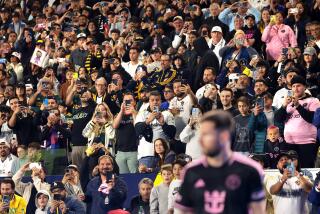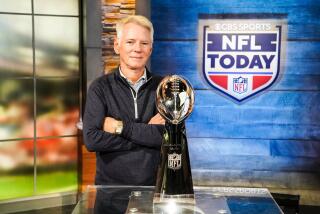10 YEARS AFTER : THE WFL : It Lasted Only 27 Months, but Its Impact Is Still Felt
Ten years ago today, the lights went out on a short, sad little chapter in the history of pro football in America. After 27 months and $30 million, the World Football League died.
On that day, on a football practice field at the Los Alamitos Naval Air Station, about 45 young men, players for the Southern California Sun, were finishing practice. They were scheduled to play Birmingham the next Sunday. Everyone was uneasy. There had been rumors.
Tom Fears, coach of the Sun, was given the word on the practice field, by his equipment manager.
“Don’t say anything to the players yet,” he whispered. Then he halted practice, told the players to take a lap, and walked to his office.
Fears telephoned the Sun office at Anaheim Stadium for confirmation. His face was grim as he listened. It was official.
“It’s over,” he said quietly to a few staff members in the office.
He entered the locker room, signaled for quiet and said: “Fellas, the league has folded.”
He spoke quietly. For most in the room, a dream was dead. It would be their final day in a pro football uniform. Yet there were no tears. A few bitter epithets broke the silence.
One player, like many in the 10-team league, believed that news reporting the WFL’s precarious financial situation had been partly responsible for the league’s collapse. He saw a reporter and spoke sharply, saying: “This is what you wanted . . . well, you got it!”
The players stripped, showered and dressed quietly. Fears remained, telling some of the team’s better players he’d help them contact NFL teams. Others dressed quickly, shook hands and left. One player wanted to keep his helmet.
“Everything has to be packed up, fellas--the club will probably have to sell all the equipment to pay off creditors,” Fears said.
Fourteen players repaired to a nearby Los Alamitos bar. For a season and a half they had played, bled and worried together. Now, at the end, they got sloshed together.
The next morning, at the team’s Anaheim Stadium offices, pictures were taken off the walls. A secretary passed out publicity pictures to players. A telephone man disconnected phones. A few players wandered about, wearing long faces.
Larry Hatfield, the team’s president, came out of his office and said: “I want everything packed up and everyone out of here as soon as possible. I don’t want to have to come to this office anymore. It’s too painful.”
By late in the day, season ticket-holders calling the club to ask about refunds were hearing: “The number you have reached is not in service at this time.” There was no new number.
The WFL is largely forgotten today, but the impact of the funny little league with the yellow footballs remains.
In fact, one former NFL player, ex-Ram Merlin Olsen, maintains that every NFL player today can thank the WFL for at least part of his salary.
“There’s no question that the WFL had a dramatic impact on NFL player salaries,” he said. “It was a time of disbelief for all of us, really. I can remember guys getting cut from the Rams who, had they made the team, would’ve made something like $40,000. Then they’d go to the WFL and make $70,000 and $80,000.
“The same thing happened when the NFL was fighting the AFL for players in the early ‘60s, and it’s happened again, with the USFL.
“The WFL never contacted me. I was near the end of my career (he retired in 1976) and happy with my situation with the Rams. I made $110,000 my last year.
“The Ram players who really made out were the guys whose contracts were up when the WFL was still around. I can remember a number of teammates of mine whose salaries went up 100%. And, remember, between the NFL-AFL merger (1966) and the WFL (1974-75), salaries didn’t go up all that much. The WFL kicked them up, dramatically.”
Sports agent Mike Trope, who negotiated several WFL player contracts, recalls that in the space of just four seasons, NFL signing bonuses and salaries went up over 1,000% in some cases.
“In 1973, the year before the WFL came along, I represented Johnny Rodgers, who was a first-round draft choice by San Diego,” he said.
“Their first offer was a $10,000 signing bonus. Their final offer was a $25,000 bonus and a first-year salary of $19,000.
“In 1976, the year after the WFL folded, I represented another first-rounder, Chuck Muncie. He got a $200,000 signing bonus from New Orleans.
“If the WFL and the USFL had never come along, I’d say NFL first-round picks would be getting maybe $100,000 signing bonuses today. This year, Bruce Smith (Buffalo) got a $1.4 million bonus, part of which was deferred compensation.”
Gary Davidson, who started the WFL--as well as the old American Basketball Assn. and the World Hockey Assn.--is still in Newport Beach, where the WFL had its headquarters its first year. At 50, he’s in the real-estate business. His name comes up with every rumor about a new football, baseball, basketball, bowling or karate league.
Fears, 65, is retired and lives in San Juan Capistrano.
Several dozen WFL players got jobs in the NFL when the league folded, but only two remain active today, the Rams’ Charles DeJurnett and Cleveland’s Gary Danielson.
More to Read
Go beyond the scoreboard
Get the latest on L.A.'s teams in the daily Sports Report newsletter.
You may occasionally receive promotional content from the Los Angeles Times.










